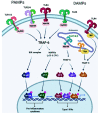TLR/WNT: A Novel Relationship in Immunomodulation of Lung Cancer
- PMID: 35742983
- PMCID: PMC9224119
- DOI: 10.3390/ijms23126539
TLR/WNT: A Novel Relationship in Immunomodulation of Lung Cancer
Abstract
The most frequent cause of death by cancer worldwide is lung cancer, and the 5-year survival rate is still very poor for patients with advanced stage. Understanding the crosstalk between the signaling pathways that are involved in disease, especially in metastasis, is crucial to developing new targeted therapies. Toll-like receptors (TLRs) are master regulators of the immune responses, and their dysregulation in lung cancer is linked to immune escape and promotes tumor malignancy by facilitating angiogenesis and proliferation. On the other hand, over-activation of the WNT signaling pathway has been reported in lung cancer and is also associated with tumor metastasis via induction of Epithelial-to-mesenchymal-transition (EMT)-like processes. An interaction between both TLRs and the WNT pathway was discovered recently as it was found that the TLR pathway can be activated by WNT ligands in the tumor microenvironment; however, the implications of such interactions in the context of lung cancer have not been discussed yet. Here, we offer an overview of the interaction of TLR-WNT in the lung and its potential implications and role in the oncogenic process.
Keywords: TLR; WNT; lung cancer.
Conflict of interest statement
The authors declare no conflict of interest.
Figures





Similar articles
-
TRIP13 promotes the proliferation and invasion of lung cancer cells via the Wnt signaling pathway and epithelial-mesenchymal transition.J Mol Histol. 2021 Feb;52(1):11-20. doi: 10.1007/s10735-020-09919-z. Epub 2020 Oct 30. J Mol Histol. 2021. PMID: 33128167
-
FOXP3 promotes tumor growth and metastasis by activating Wnt/β-catenin signaling pathway and EMT in non-small cell lung cancer.Mol Cancer. 2017 Jul 17;16(1):124. doi: 10.1186/s12943-017-0700-1. Mol Cancer. 2017. PMID: 28716029 Free PMC article.
-
Astrocyte elevated gene-1(AEG-1) induces epithelial-mesenchymal transition in lung cancer through activating Wnt/β-catenin signaling.BMC Cancer. 2015 Mar 8;15:107. doi: 10.1186/s12885-015-1124-1. BMC Cancer. 2015. PMID: 25880337 Free PMC article.
-
Toll-Like Receptors (TLRs) in the Tumor Microenvironment (TME): A Dragon-Like Weapon in a Non-fantasy Game of Thrones.Adv Exp Med Biol. 2020;1263:145-173. doi: 10.1007/978-3-030-44518-8_9. Adv Exp Med Biol. 2020. PMID: 32588327 Review.
-
Wnt Signaling and Its Significance Within the Tumor Microenvironment: Novel Therapeutic Insights.Front Immunol. 2019 Dec 16;10:2872. doi: 10.3389/fimmu.2019.02872. eCollection 2019. Front Immunol. 2019. PMID: 31921137 Free PMC article. Review.
Cited by
-
Interplay between WNT/PI3K-mTOR axis and the microbiota in APC-driven colorectal carcinogenesis: data from a pilot study and possible implications for CRC prevention.J Transl Med. 2024 Jul 5;22(1):631. doi: 10.1186/s12967-024-05305-5. J Transl Med. 2024. PMID: 38970018 Free PMC article.
-
Cytotoxic Activities and the Allantoinase Inhibitory Effect of the Leaf Extract of the Carnivorous Pitcher Plant Nepenthes miranda.Plants (Basel). 2022 Aug 31;11(17):2265. doi: 10.3390/plants11172265. Plants (Basel). 2022. PMID: 36079647 Free PMC article.
-
The role of TLR-4 in chemoresistance of cancer.Discov Oncol. 2025 May 22;16(1):865. doi: 10.1007/s12672-025-02509-z. Discov Oncol. 2025. PMID: 40404908 Free PMC article. Review.
-
A comprehensive review of Sjögren's syndrome: Classification criteria, risk factors, and signaling pathways.Heliyon. 2024 Aug 15;10(17):e36220. doi: 10.1016/j.heliyon.2024.e36220. eCollection 2024 Sep 15. Heliyon. 2024. PMID: 39286095 Free PMC article. Review.
-
Toll-like receptor-guided therapeutic intervention of human cancers: molecular and immunological perspectives.Front Immunol. 2023 Sep 26;14:1244345. doi: 10.3389/fimmu.2023.1244345. eCollection 2023. Front Immunol. 2023. PMID: 37822929 Free PMC article. Review.
References
Publication types
MeSH terms
Substances
Grants and funding
LinkOut - more resources
Full Text Sources
Medical

